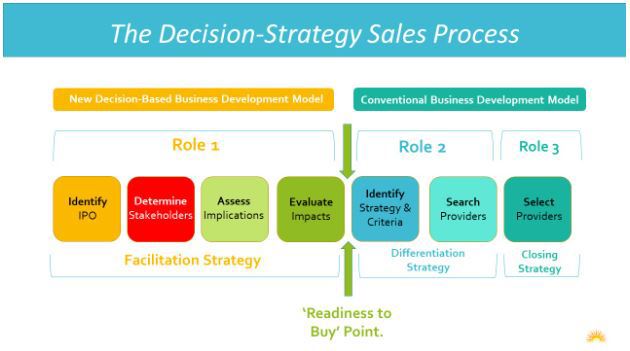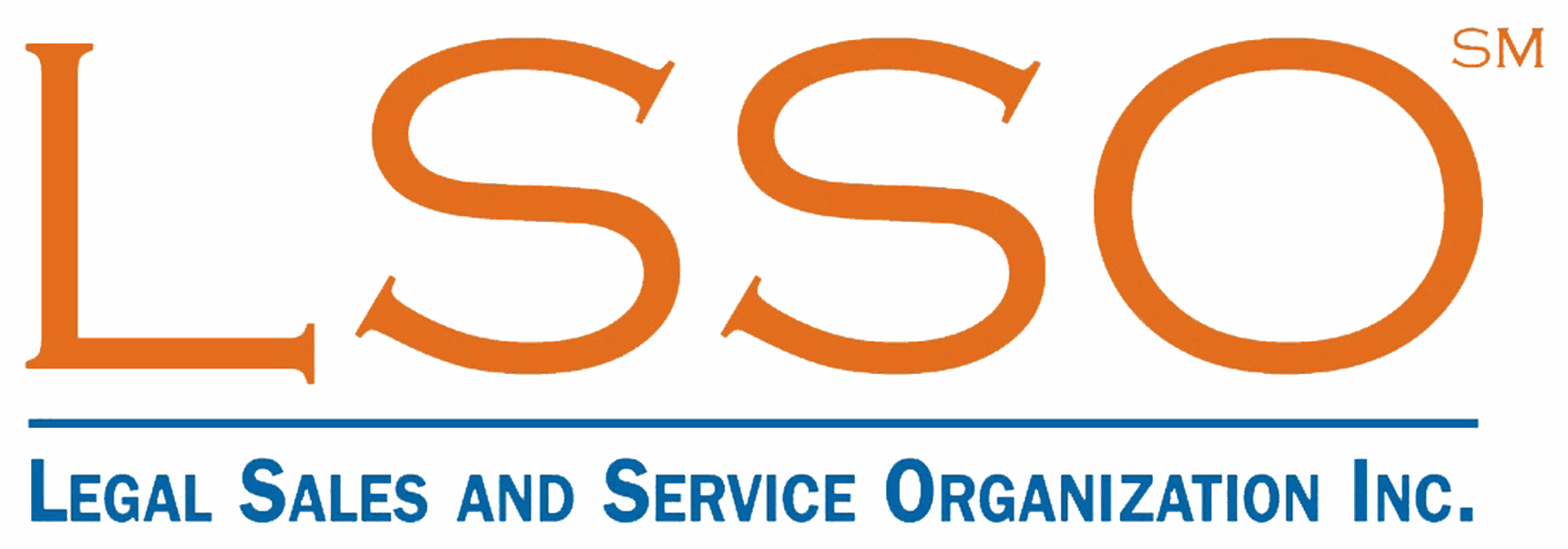By Eric Dewey, MBA, eLegal Training, LLC
Conventional business development training programs follow a familiar path. They teach lawyers to: find qualified prospects; make connections; build relationships; identify legal needs; make a proposal; overcome objections and close the engagement. Sound familiar?
As popular as this business development process is, it can’t explain fundamental challenges that we see so often in our business development pursuits. For instance,
- why a prospect stalls or disengages from the selling process,
- why new decision makers sometimes enter sales discussions,
- why lawyers with a strong company relationship are not always selected,
- why some engagements get signed quickly and some take months, and
- why some prospects recognize a legal need but don’t solve their problem.
Without a good explanation for this seemingly erratic behavior we conclude business services buyers are, at least sometimes, ‘irrational’ or ‘emotional’- a characteristic of individual consumers, but not corporations. Consumers are motivated by the experience the purchase promises, an emotional pursuit. Business people, on the other hand, are motivated by the expectation of profit the purchase will produce, a decidedly rational pursuit. If these responses, then, are not irrational, it suggests there is something missing in our understanding of the buying process.
Unknowingly, legal business development training has adopted certain assumptions that mask the fact that our selling process is fundamentally flawed. We teach a process that, in practice, only works in a fraction of selling situations. To compensate, we urge ourselves and our time-constrained lawyers to increase the volume of contact. When the process doesn’t work, we blame the buyer, the ‘lawyer personality’, their unwillingness to sell, or the buyer’s resistance to being ‘sold’. Instead, we should look closer at what we’re teaching our lawyers, or more accurately, what we’re not teaching them.
The legal sales/business development process has assumptions embedded in it that distort the errors in the selling methodology. It assumes that:
- When companies recognize a legal need, they are inclined to buy a solution. (Not always.)
- There is one ultimate decision maker. A key to success requires access to this person. (There are many influencers in the decision. Ultimate decision makers manage decision consensus.)
- Close relationships are the best path to new engagements. (Not necessarily, expertise does it too.)
- There is a single, linear sales method that works for all selling/buying situations, all lawyer/sellers, all practice areas, and all buyer types. (Legal services don’t fit neatly into a single method. The practice area/legal need significantly influences the purchasing process and time frame.)
Conventional business development methods ignore an important part of the buying - selling process: the buying decision process. This is a process that occurs prior to a company’s decision to solve an issue, problem, or opportunity (IPO) and it is the source of much of our frustration with selling. It’s surprisingly sensible. So much so that this plain truth is overlooked. A company will not be ready to buy until it has decided to buy the services of outside counsel. That decision has two parts: the first decision to solve the problem and the second decision of which provider to use. We tend only to focus on the latter in our sales training.
A company’s buying decision process includes much more than simply the recognition of an IPO and the selection of a provider. The buying decision process includes a unique internal process, obscured from view, that prioritizes, builds consensus and projects outcomes for the array of possible solutions. This internal buying decision process happens before a company can find a solution or a provider and yet it is fertile ground to influence the decision, the selection criteria and even the choice of provider.
We can’t fully understand how buyers buy until we have insight into how buyers decide to buy. Focusing on the decision to buy completely changes almost everything we know about ‘selling’. We learn to listen for sales opportunities and respond to those ‘sales triggers’ by ‘selling’ our services or attempting to persuade the buyer of our unique offering. Companies, however, are not always ready to buy even when they’ve discussed the possibility. A view into the internal decision process demonstrates the complexity of the buying process in matrixed, profit driven organizations. Without that internal view, we don’t understand that ‘selling’ is useless, even counterproductive at certain points. ‘Selling’ before a company is ready to buy creates ‘sales pressure’ that ignites skepticism and makes relationships harder to form. Without internal consensus, no amount of selling, relationship building, negotiation skills or discounting will move companies to engage, a fact that has been widely overlooked in conventional business development and sales training.

Companies at different stages of their buying process react differently to our business development initiatives because their level of readiness to engage outside counsel is more or less matured. For example, a lawsuit that threatens the company’s survival requires little consensus-building within the company. There is quick and strong agreement to defend the company against the action. However, a company considering strategic acquisitions has to do some homework. They need first to understand how the acquisition will affect financial, operational, human resource, and other corners of the business before they can get the multifunctional agreement to proceed. Lastly, a company asked by an earnest seller to consider changes to their licensing agreements or technology contracts, is even further behind in their internal decision-making process. They have to determine first whether to address the issue and then how to address the issue in a way that creates the least disruption to the company’s operations. Yet, lawyer/sellers are taught to pitch their services in the same way regardless of where the company is in their internal buying decision process. This results in little success and lots of frustration.
It's not hard to understand why the internal buying decision process has been left out of sales training. Outside counsel is, obviously, on the outside of the company. Outside lawyers are not privy to the internal politics, the relationship dynamics, the cultural norms and values, the history and hard-fought lessons that determine how the company operates, how it makes decisions, and how it selects providers. It’s hard to see how they could influence internal buying decisions.
They can, however, help facilitate the decision process from outside by helping their contacts ask better questions, get better information, understand the stakeholders, and more clearly understand the resistance to the changes some legal solutions will cause inside the company. They can help facilitate the internal decision process in the same way a counselor might advise you in assessing your career options- they don’t care what career path you take, only that you make a decision. Fortunately, it doesn’t require a deep understanding of each company’s business or industry, only a change in mindset and a new questioning strategy. That’s not to say it’s not helpful to understand the company’s business or industry, its simply more helpful to understand its culture because business decision facilitation is actually cultural change facilitation.
Expanding our definition of the selling process to include the company’s buying-decision process sheds light on the internal dynamics, motivations and time frames companies have about solving their legal problems. This revelation led to a new business development process called Decision-Strategy Selling™ that provides lawyers with a framework to evaluate where the buyer is in their internal buying decision process and presents a new set of skills to help find the quickest path to an engagement decision. It complements existing sales training because it helps lawyers pinpoint the situations in which selling skills will be most effective. And it builds relationships more quickly because the lawyer is more often able to start the relationship as a trusted advisor and not as a sales person. In short, Decision-Strategy Selling™ gives lawyers more company insights and more opportunities for the types discussions that lead to engagements.
 Eric Dewey, MBA, is the Founder of eLegal Training, an online business development training, coaching, resource and referral network platform. He is the creator of Decision - Strategy Selling, a more effective path to new legal engagements and would love the opportunity to incorporate the buying decision process into your sales training. Contact or visit eric@elegaltraining.com or visit http://www.elegaltraining.com.
Eric Dewey, MBA, is the Founder of eLegal Training, an online business development training, coaching, resource and referral network platform. He is the creator of Decision - Strategy Selling, a more effective path to new legal engagements and would love the opportunity to incorporate the buying decision process into your sales training. Contact or visit eric@elegaltraining.com or visit http://www.elegaltraining.com.

